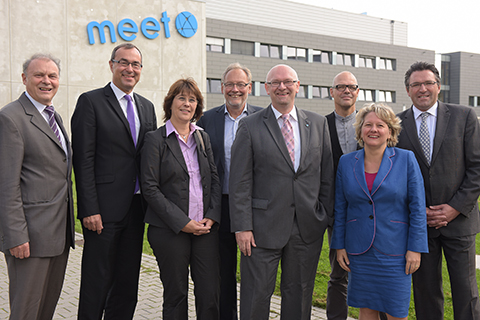Battery Research Center MEET Turns Five
Five years of battery research at MEET – this anniversary was an occasion for Prof. Martin Winter, Dr. Gerhard Hörpel and their team of scientists to invite project partners and sponsors to a celebration, and to take stock of what has been achieved to date. Almost 100 guests came to Münster University (WWU) today (1 September) and gained an impression of how the MEET facilities, research and other activities touching on electrochemical energy storage have developed. Among those who came to congratulate MEET was Svenja Schulze, the Minister for Innovation, Science and Research of the State of North Rhine-Westphalia.
“The transition to renewables has been decided at the political level. Against this background, it is all the more important to work on alternative methods of energy production and storage,” the minister said. Three doctoral candidates gave short talks giving the guests insights into the possibilities and potential of battery research. Visitors also took advantage of the opportunity to look over the laboratories.
Since the start of 2011, the researchers at MEET – currently more than 150 staff from 12 different countries – have been housed in a dedicated 4500-square-meter building that was erected in just 11 months. The scientists are involved in around 50 projects, either publicly financed or carried out in cooperation with industry, that investigate questions such as how the energy density of batteries can be enhanced, how their safety can be improved and how costs can be minimized.
The main focus of work at MEET is on electrolyte research. The electrolyte is a central component of batteries, enabling as it does the flow of current within the cell. There are however, many other associated issues that the scientists engage with in their bid to develop battery technology for widespread use in electrical vehicles and stationary facilities. And they face questions such as: In which applications is the potential of lithium-ion batteries exhausted? What technologies do we need besides lithium-ion technology? The research results in a large number of publications, lectures and patent applications. In view of the many questions still needing investigation, Martin Winter, who according to the latest ranking figures of the US media corporation “Thomson Reuters” is one of the most-cited scientists in the world, says: “These five years have just been the beginning – many others will follow.”
The acronym “MEET” stands for “ "Münster Electrochemical Energy Technology". At the same time, the word MEET gives a clear picture of what happens at the battery research center:
researchers from all over the world work on the energy storage devices of the future across all specialist boundaries.














